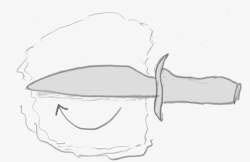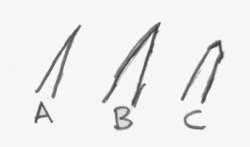Knife
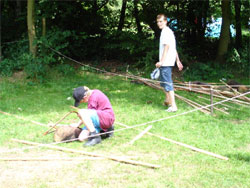
Introduction
A knife is perhaps one of the most useful tools you could have at camp. Given enough time, patience and ingenuity most problems can be solved with the safe use of a knife and its application.
Choosing a knife
The multi-bladed type knifes ('Swiss army knife') can be useful, but if you only have a single knife you will need something stronger with a general purpose blade.
You can buy some knives that have a compass built into the handle, or have the handle hollowed out so that you can carry equipment inside it. However I would consider this a waste of money. The compass will eventually lose its accuracy after the knife has been used (especially if you use it on hardwoods), and the hollow handle will soon break with use.
The only two general purpose knives I would recommend are a decent folding knife, and a strong 'handled' knife (err, that is a poor name of my own choosing. I wasn't sure how to explain it. I just mean an 'ordinary' knife).
As far as the blade goes, for scouting purposes I would steer clear of the ones on the market that boast several different edges over the length of the blade (serrated, skinning, saw etc. The 'survival' type knifes). I would simply opt for a knife with a good clean edge, that perhaps does have different levels of fineness to the edge along the length of the blade.
Safety Issues
A knife can be an invaluable asset in all kinds of situations. However you must remember that knives are dangerous, and can be weapons. Safety should always be of paramount importance. No-one (and this includes leaders!) should be allowed to carry or handle a knife unless they have proven their competence to an experienced instructor. I would not allow scouts to carry knives on their person at camp all the time, only when the activity specifically requires the use of knives. I would certainly never allow anyone to carry a knife on their person off the site, there is simply no need for it. Offsite the knife should be safely stored in your backpack.
Remember you are only as sharp as your knife. You must keep your knife sharp ready for use, a blunt knife is a dangerous instrument and an inefficient tool. Don't misuse your knife. Never throw it into trees or the ground. Keep it clean, and if you don't intend to use it for a while, oiled and in its sheath.
Folding knives
A folding knife can be very useful, provided it has a good locked position. If the blade does not lock firmly, forget it, look elsewhere. A blade within a wooden handle will be the most comfortable as it will not slip when your hands get sweaty, and if the handle is made from a single piece of wood, it is less likely to cause blisters than other types.

Sheaths
A sheath is a must for any normal knife. Always replace the knife in its sheath when not in use, even if only for a minute or so of inactivity. A sheath should be made from strong, stitched leather, with a tunnel belt loop. Ensure that it has a positive fastening to secure the knife. Some sheaths may have additional small pockets for a penknife or a sharpening stone. These could be useful to have.
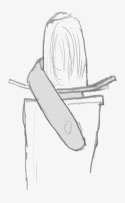
'Handled' Knife
By a 'handled' knife I just mean an ordinary general purpose bladed knife. Take care to choose the handle. A single, rounded piece of wood is ideal, with the knife tang passing through it and fastened at the end. This way if the handle breaks the tang can be wrapped with cloth or twine.
The middle picture shows a handle that is only riveted to the tang and would quickly cause blisters.
The bottom picture shows a handle that could break at the rivets if subject to heavy work and the short tang would make it difficult to replace the handle.
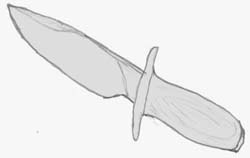
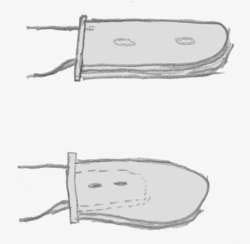
Sharpening
If you don't have a sharpening stone for your knife, remember that any sandstone will sharpen tools (a grey, clayey sandstone being the best). Quartz is good, though rare, and granite can also be used. Rub two pieces together until they are smooth. A double- faced stone with a rough and a smooth surface will be ideal and should be carried in the sheath pocket.
Use the rough surface first to remove burrs, then the smooth one to get a fine edge. The object is not to get the sharpest edge possible, but to get an edge that will last and not chip.
To sharpen the blade, hold the handle in the right hand. Use a clockwise circular motion and apply a steady pressure on the blade with the fingertips of the left hand as you push away. Keep the angle constant. Keep the stone wet. Rock particles on the blade will show the angle you are obtaining. Do not drag the blade towards you under pressure as this will produce burrs. Reduce the pressure for a finer edge. Work counterclockwise on the other side.
Blade profile
A is too fine and might chip
B is good
C is too steep and will wear quickly
